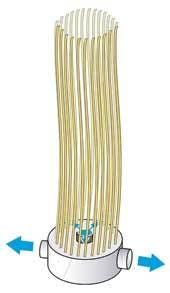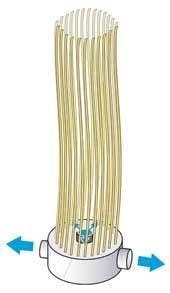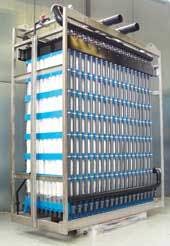Membrane bioreactor (MBR) technology using submerged membrane modules is being used increasingly for municipal and industrial wastewater treatment applications. MBRs considerably improve the quality of discharged effluent and require less space compared to conventional methods. This technology may be of particular interest to countries with water shortages because effluent from MBR plants can be used for irrigation, process water applications, or as an initial step in the process of treating wastewater for indirect potable reuse.
Although MBR systems have historically been more expensive than conventional treatment technologies, the use of new submerged membrane module technologies has narrowed the gap, while offering distinct advantages over conventional treatment. The PuronTM submerged membrane module developed by Koch Membrane Systems GmbH (Aachen, Germany) significantly reduces MBR lifecycle costs when compared to other submerged membrane modules. These improved lifecycle costs, combined with the quality effluent and smaller footprint offered by membrane bioreactors, make this technology an attractive alternative to conventional wastewater treatment.
An MBR combines the principle of biological wastewater treatment with the advantages of using a membrane process to separate solids from liquids. Compared with conventional technology, MBRs offer two main advantages: better effluent quality and approximately half the footprint. The smaller space requirement results from the ability of the membranes to concentrate solids without reducing effluent quality.
In an MBR, ultrafiltration membrane modules are submerged in the activated sludge to combine the biological step and the solid-liquid separation into a single process. Since the membrane acts as a barrier, this improves effluent quality. Also, the membrane barrier eliminates the secondary clarifier and allows the activated sludge to be more concentrated. This reduces the volume requirement for biological tanks, thus saving space and money. Overall, the MBR process reduces footprint significantly compared to the combination of wastewater treatment followed by sand filtration or ultrafiltration. The footprint savings due to the wastewater treatment plant alone can be as much as 50%, and there are additional footprint savings since the additional tertiary filtration steps are eliminated.
There are many different configurations of MBR technology. The Puron submerged hollow fiber UF module, which will be displayed at the 2007 AWWA ACE exhibition, optimizes both the membrane and the module design. The patented module is designed to avoid clogging and sludging, conditions that are serious issues in other MBR module designs. The Puron module features hollow fiber membranes with a pore size of approximately 0.05 micron. The lower ends of the membrane fibers are fixed in a header while the upper ends are individually sealed and are free to move laterally. All solids and particulates remain on the outside of the fibers while permeate is sucked out of the inside of the fibers by means of a vacuum.
The fibers are arranged in bundles and are submerged vertically into the activated sludge. To maintain the filtration rate of the membrane modules, air scouring is carried out at regular intervals. An air nozzle is integrated into the center of the bundles to introduce the air for scouring purposes. The central arrangement of the air nozzles inside the membrane bundles reduces energy consumption, since air is injected at the place where the risk of sludging is highest. The module design allows hair and fibrous compounds to be removed reliably from the system, so that a coarse prescreen can be used, thus improving capital and operating costs.
A special feature of these membranes is their enormous mechanical strength, which is provided by a braid inside the membrane material.
The individual fiber bundles are connected in rows. Several of the rows are mounted in a frame made of stainless steel to form a module. The free-moving fibers combined with central aeration provide stable filtration during plant operation, long membrane life, and lower operating costs by reducing the need for energy, cleaning and maintenance.
When used in a membrane bioreactor, these membranes are useful in treating both municipal wastewater and wastewater from numerous industrial sources.





